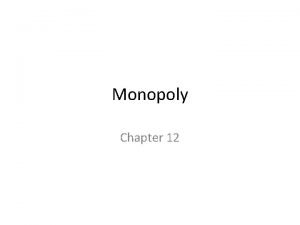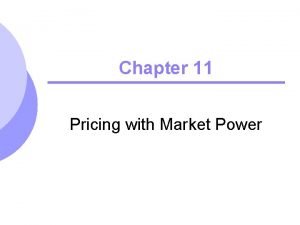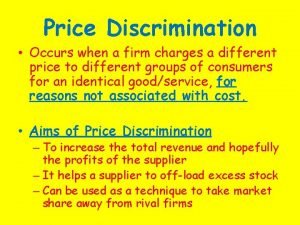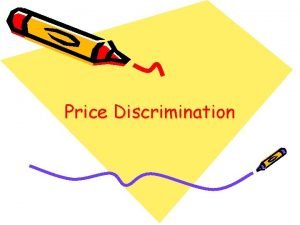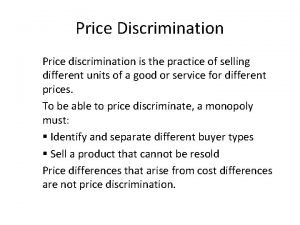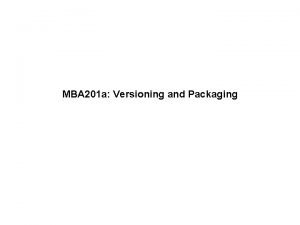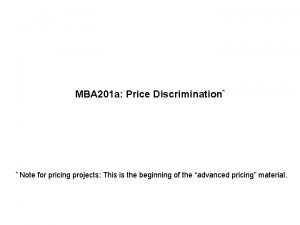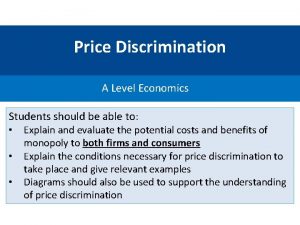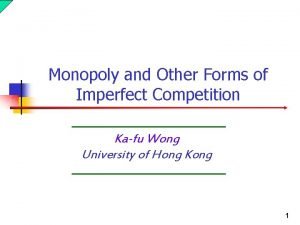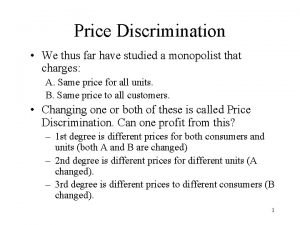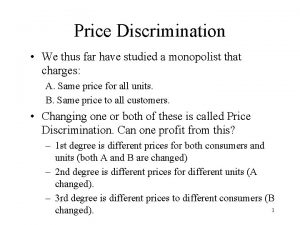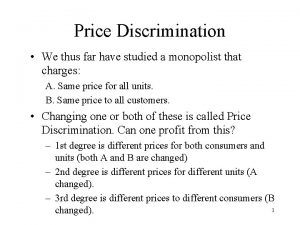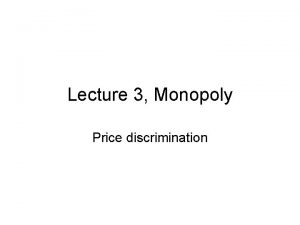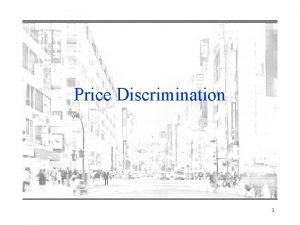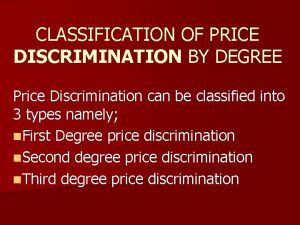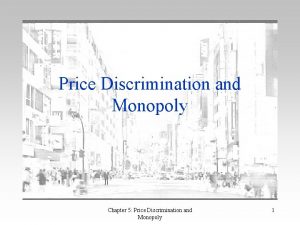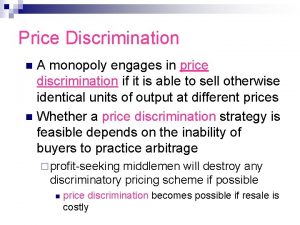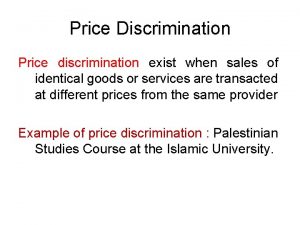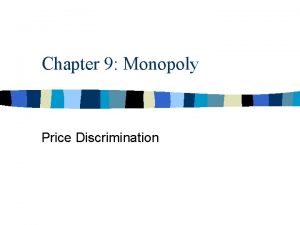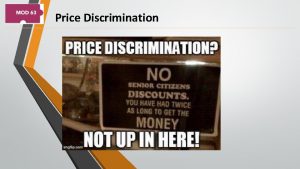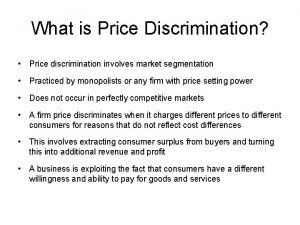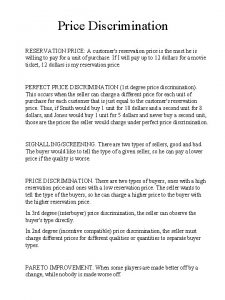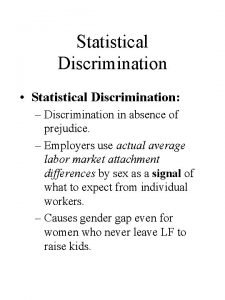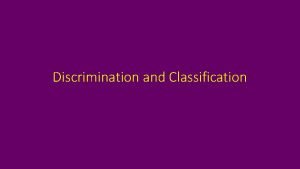Price Discrimination We thus far have studied a





















- Slides: 21

Price Discrimination • We thus far have studied a monopolist that charges: A. Same price for all units. B. Same price to all customers. • Changing one or both of these is called Price Discrimination. Can one profit from this? – 1 st degree is different prices for both consumers and units (both A and B are changed) – 2 nd degree is different prices for different units (A changed). – 3 rd degree is different prices to different consumers (B changed). 1

1 st-Degree Price Discrimination • Different prices for both consumers and units. • To do this properly, a monopolist must have strong information on: – Consumers’ preferences. – Who is who. • 1 st degree captures the whole consumer surplus. • 1 st degree is efficient. 2

Effort to Discriminate • In 1990, IBM introduced the Laser. Printer E. • The difference is that it printed 5 ppm rather than 10 ppm. • They did so by ADDING 5 chips in the E model. The purpose of the chips was to make the printer WAIT. • The price of the new laserprinter E was 60% of the old one. • Why did IBM pay for a reduction in the speed? 3

Effort to Discriminate Model • Jim values the faster printer at 1000 and the slower printer at 700. • Sean values the faster printer at 700 and the slower printer at 600. • It costs 450 to make the faster printer and 475 to make the slower printer. • What should IBM charge for either printer? • If IBM only sells the fast printer, what should it charge? • If IBM wants to sell the fast printer to Jim and the slow printer to Sean, what is the max/min price difference. • What happens if the fast printer is priced at 1000 and the slow printer 600? 4

Other Examples of Effort to Discriminate • Intel with its SX processors had the math coprocessor disabled. • Fast delivery service may hold back packages that are 2 nd day rather than overnight. • Photo shops won’t give you films in 1 hour even though they may be ready if you have ordered the longer service. • Sony Minidisc 60 minute vs. 74 minute versions minidiscs are the same except for a code on the 60 minute version written to stop it from writing the longer time. • Hard disks in MP 3 players. Sometimes is cheaper to buy the MP 3 player and take out the hard disk. People did this so they had to take precautions. 5

nd 2 degree Price Discrimination • Ari values 1 umbrella at 20 pounds and has no need for another umbrella. • Jodi values 1 umbrella at 30 pounds and also values 2 umbrellas at 40 (together). • They each want to maximize the difference between their value and the price they pay. • What is the maximum a monopolist with marginal cost of 5 could make charging the same price per umbrella? • What is the max it could make charging a price for 1 and a special for two together? • Hint: what would happen if they charge 20 for one 6 and 40 for two?

nd 2 degree Price Discrimination • Ari values 1 umbrella at 10 pounds and has no need for another umbrella. • Jodi values 1 umbrella at 30 pounds and also values 2 umbrellas at 40 (together). • They each want to maximize the difference between their value and the price they pay. • What is the maximum a monopolist with marginal cost of 5 could make charging the same price per umbrella? • What is the max it could make charging a price for 1 and a special for two together? 7

More formal • This is a mechanism design problem for the monopolist. • What is the optimal mechanism for the monopolist to use? • The monopolist wishes maximize profit subject to two types of constraints. – IR (Individual rationality): It is worthwhile for a buyer to agree buyer has an incentive to purchase a good. – IC (Incentive compatibility): One buyer should not have incentive to pretend to be another. 8

Example. • What is the best way to get Ari to buy one umbrella and Jodi to buy 2? • Denote the valuations for one umbrella and two umbrellas as A 1 and A 2 for Ari and J 1 and J 2 for Jodi. Assume J 1>=A 1 and J 2 -J 1>A 2 -A 1. • Prices are P 1 for one and P 2 for two. • IR constraints say A 1>=P 1 and J 2>=P 2 • IC constraints say that J 2 -P 2>=J 1 -P 1 and A 1 -P 1>=A 2 -P 2. 9

Rewriting • IC constraints: J 2 -J 1>=P 2 -P 1>=A 2 -A 1 • Only difference matters so we want either P 1=A 1 or P 2=J 2. • If we make P 2=J 2, then we must have J 1<=P 1. This then would imply P 1>=A 1. • So we make P 1=A 1. We then want to increase P 2 as much as possible, until J 2 -J 1=P 2 -P 1. Hence P 1=A 1 and P 2=J 2 -J 1+A 1. In our first example, A 1=20 and P 2=40 -30+20=30. 10

Movie Release Dates • Studios want to maximize revenue. • Groups want the delay from the Theater release to be short and the release to the next outlet to be long. • Consumers must decide when (if) to watch the film. • What incentive does the studios have once the consumers have made their decision? 11

Movie Release: A simple model. • There are only two formats: Theater and Home. • The home release can be early or late. The studio gets £ 5 for each Theater sale and £ 2 for each home viewer. • Four Consumers. – A only wants to see the movie in theater. – B only wants to see the movie at home. – C will see the movie in theater if the release is late. Otherwise, C will see it at home. – D will see the movie at home only if the release is early. • What is studio profit for early? Late? What should the studio do? 12

Movie Release: further analysis • After the studio announces release date and the movie is released, what should it do? • What stops this from happening each time? Consumers judge the release date not by what the studio says, but by either previous record or what the studio has incentive to do. • Do you remember which studio produced the Titanic? • If consumers judge the industry as a whole rather than individual studios, then what happens? 13

International Pricing of Pharmaceutical Companies Prices of antipsychotic drug in various countries. Why such a difference? 14

3 rd-degree price discrimination • There are two groups of people that make up total demand D(p)=D 1(p)+D 2(p). • Example: MC=0, D 1(p)=100 -p and D 2(p)=60 -p. • q=D 1(p)+D 2(p)=160 -2 p. • We find p=80 -q/2. Marginal revenue is 80 -q. • MR=MC implies q=80 and p=40. • Profit with one price is 3200. • MR in market 1 is 100 -2*q 1 and in market 2 is 60 -2*q 2. • Find q 1, q 2, p 1 and p 2. • Show that combined profits are 2500+900=3400. • At home: Try the same for D 1(p)=100 -p and D 2(p)=100 -p. • Need to ensure one group can’t sell to another (leakage). • Companies try to prevent leakage and take advantage when 15 it is limited: DVDs and camcorders (PAL vs. NTSC).

Examples of Price Discrimination. • Book publisher having a cheap international edition of a book. • How about paperbacks. • Publisher charging libraries a higher rate to libraries than to individuals. • Frequent Flyer Programs. • First Class Train tickets. • Saturday stayover for airfares. 16

Two-Part Tariffs • The sports center charges a fee to join and then a per usage fee. • Why don’t they just charge one or the other to make it simple? • What form of price discrimination (if any) is this? • Sometimes this may have a high transaction cost: Disneyland dilemma. 17

Other two-part pricing • This is also the case with video games such as the Xbox. • We also saw this with IBM and its punchcards (overpriced). • There are two types of consumers. – A is a heavy user and will make calculations all day long: needs 100 punch cards. – B is a light user and will need to make calculations only at the end of the day: needs 50 punch cards. – C is a hobbiest and would only fool around with the machine: needs 5 punch cards. • The value of each calculation is £ 100 (over the year). C values owning the machine at £ 1000. The machine costs £ 3000 to produce and punch cards 18 £ 0.

Two-part tariff: punch cards • What is the monopoly’s profits if it charges 0 for each punch card? • What happens if the monopoly charges 0 for the machine and only for the punch cards? • What happens if the monopoly charges £ 1500 for the machine and £ 70 each punchcard? 19

Bundling • Two types of people: – A values $120 for Word, $100 for Excel. – B values $100 for a Word, $120 for Excel. • If Microsoft charges separately for each program, it can make $200 for each software product for a total of $400. • They could package both together (and stop selling it individually) and sell it for $220 making a total profit of $440. 20

Anti-Competitive Bundling • A library has £ 10, 000 to spend on journals. • There are 10 good journals out there. • They want to buy as many journals as they can for the budget as long as each journal is less than £ 2000. • Six journals are owned by one publisher -E. • The 4 independent journals cost £ 1000 each. • What is the maximum the E can make if it charges a separate price for each (assume marginal cost is zero)? • How about if E bundles all 6 together? • If E bundles all together, what can the independent 21 journals do?
 Our fears in banquo stick deep
Our fears in banquo stick deep Ang price ceiling ay kilala rin sa katawagang bilang
Ang price ceiling ay kilala rin sa katawagang bilang Civilized dome riding all cities figure of speech
Civilized dome riding all cities figure of speech Awarding the world its world
Awarding the world its world In a kingdom far far away
In a kingdom far far away Far far away city
Far far away city Peak load pricing
Peak load pricing Theory of monopoly
Theory of monopoly First degree price discrimination
First degree price discrimination Second degree price discrimination graph
Second degree price discrimination graph Price discrimination occurs when a firm
Price discrimination occurs when a firm Price discrimination examples in real life
Price discrimination examples in real life Student discount price discrimination
Student discount price discrimination Perfect price discrimination
Perfect price discrimination Objectives of price discrimination
Objectives of price discrimination Deadweight loss monopoly
Deadweight loss monopoly Versioning price discrimination
Versioning price discrimination Explain price discrimination
Explain price discrimination Hurdle model of price discrimination
Hurdle model of price discrimination Calculus vs algebra
Calculus vs algebra If you had studied hard you would have succeeded
If you had studied hard you would have succeeded George gray poem answers
George gray poem answers







